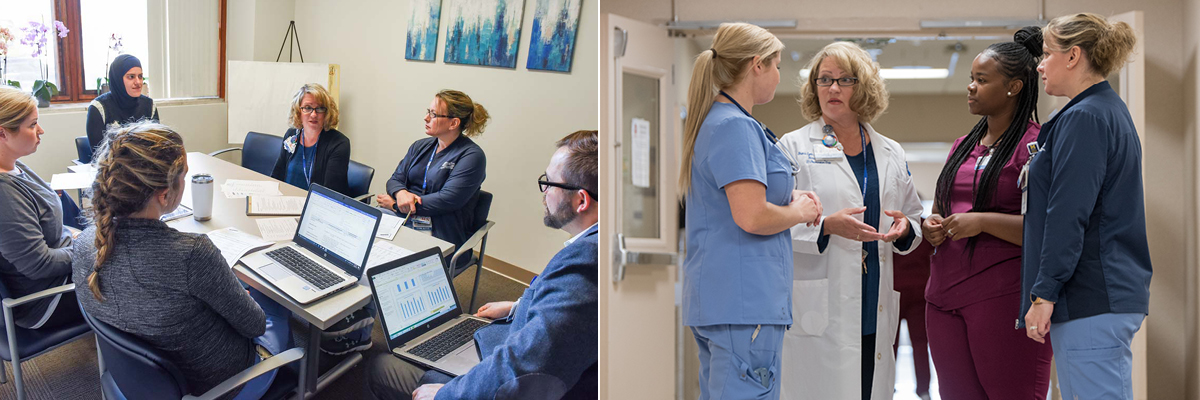Transformational Leadership
 Nursing leaders at Henry Ford Hospital (HFH) help empower our nurses to positively impact lives every day. They play a large role in our hospital’s success by transforming values, beliefs and behaviors to meet future needs.
Nursing leaders at Henry Ford Hospital (HFH) help empower our nurses to positively impact lives every day. They play a large role in our hospital’s success by transforming values, beliefs and behaviors to meet future needs.
Our nurse leaders engage their teams in innovation, research and evidence-based practice to improve clinical and organizational outcomes. Clinical nurses embrace this philosophy and transform bedside care.
Making a difference in patient’s lives
Journey to telemetry
 The Henry Ford Hospital (HFH) F2 General Medicine and Pulmonary Unit cares for patients that have had a lung transplant, those waiting for a lung transplant, acute and chronic respiratory failure and pulmonary hypertension.
The Henry Ford Hospital (HFH) F2 General Medicine and Pulmonary Unit cares for patients that have had a lung transplant, those waiting for a lung transplant, acute and chronic respiratory failure and pulmonary hypertension.
Meeting the specialized needs of these fragile patients can be challenging. Clinical nurses from F2 raised concerns about their ability to monitor the respiratory status of these patients.
To help, the nurses worked with F2 Nurse Manager Brenda Belbot MSN, RN-BC, and developed the idea to add telemetry with pulse oximetry monitoring for better assessment of their patients.
“Nurses who advocated for telemetry monitoring improved safety for the unique patient population we have,” says Belbot. “We are always trying to do our best for our patients.”
In February 2018, an interprofessional team consisting of F2 nurses, intensive care unit (ICU) nurses, nursing leadership, respiratory therapy, physicians and administration worked together and were approved for six telemetry monitored beds. These would allow for continuous monitoring of a patient’s oxygen level and respiratory rate.
Belbot partnered with pulmonary staff physician and F2 Medical Director Daniel Ouellette MD, to develop a protocol for admission criteria to the telemetry monitored beds as well as specific care for the patients. Belbot then educated her team members through telemetry education provided by HFH Nursing Education, daily huddles and the unit’s shared governance committee.
F2 nurses participated in telemetry training, and a representative from Phillips also came to provide education and training on the new telemetry equipment. “With the strong lead from our nurses, they became empowered to teach and mentor each other,” says Belbot. “It was great to watch them take ownership.”
By June 2018, the six telemetry rooms were ready. The telemetry beds assisted in improving patient flow from the ICU and the continuous oxygen monitoring allows the nurses to anticipate patient needs and develop patient-specific care plans.
CUSP
Building a culture of safety

At the beginning of 2019, Henry Ford Hospital (HFH) began preparation to implement a new hospital-wide safety program called CUSP. CUSP stands for Comprehensive Unit-based Safety Program and aims to improve the culture of safety by providing frontline staff with the tools and support needed to speak-up and identify concerns related to potential patient harm. The goal of CUSP is to identify potential patient harm using the question “how will your next patient be harmed?”
In April, two units, I1 Observation and B2 Cardiology/Short Stay, were identified to travel to Baltimore, Maryland to be trained by the founders of the program at Johns Hopkins Hospital. When they returned to HFH, they brought their new knowledge back to their units and began creating a CUSP team.
“The CUSP team leads the unit in preventing patient harm,” explains I1 Nurse Manager Sheri Nelson, MSN, BSN, RN. “They are made up of a nurse lead, physician lead, CUSP champion, executive sponsor and a unit safety champion.”
Since I1 is a busy and fast-paced unit, two nurse champions and two provider champions lead the team. I1 sees an average of 220 patients each week as most are there for 24 hours or less. Due to the high turnover in beds, safety must always remain a top priority.
CUSP was developed with the goal to standardize care, create a culture based on speaking-up and a reduction and elimination of harm. It has proven to help with a range of safety issues, including patient falls, hospital-acquired infections, medication errors, teamwork, communication barriers and more.
A focus on safety further supports our journey to becoming a high reliability organization (HRO). Although the CUSP work is just beginning at HFH, teams are excited to be involved in building a culture based on safety for each patient, visitor and team member that comes to the hospital.
Next Section: Structural Empowerment >>
.svg?iar=0&hash=F6049510E33E4E6D8196C26CCC0A64A4)

/hfh-logo-main--white.svg?iar=0&hash=ED491CBFADFB7670FAE94559C98D7798)